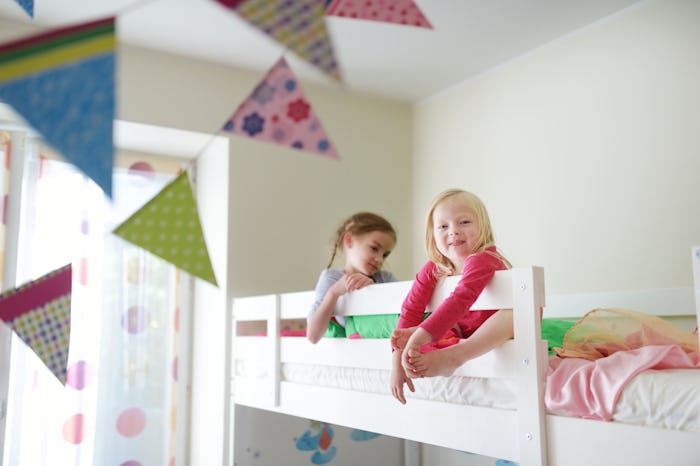Life

Here's When Your Kiddos Are *Really* Ready For A Bunk Bed, According To Experts
There’s something so fun about bunk beds for kids — friends can bunk together during sleepovers, and siblings can stay up late giggling and pretending to be asleep when their parents check on them. And for parents, they sure do save space. But at what age can bunk beds be used safely? As it turns out, national safety experts have a lot of concerns about them, and rightfully so.
The Mirror reported that in early July 2019, an 11-year-old girl died after accidentally hanging herself from the top bunk. This tragedy sparked questions about how safe bunk beds are, even for older children. Sadly, her story isn’t an isolated incident. The Nationwide Children’s Hospital’s website stated that approximately 36,000 bunk bed-related injuries occur every year to children in the U.S. They say most bunk bed-related injuries occur from falls off the top bunk while sleeping or playing; that the most common injuries are cuts, broken bones, and bruises; and that injuries most often occur to the head and neck. The site noted that half of these injuries happen to children younger than 6 years.
“The recommendation is not to put a child in that top bunk until they’re at least 6 years old, with the main risk being falls,” says Cynthia Dennis, RN, coordinator of Safe Kids Northeast Florida at Wolfson Children’s Hospital of Jacksonville, in an interview with Romper. “It’s really important to teach them proper bunk bed behavior — that they’re not to jump on it or jump off of it — or play around on the top bunk. Above all else, the number one thing that sends children to a trauma center is falls, and the injuries from a fall out of a bunk bed are worse than other beds because, of course, they’re higher.”
The United States Consumer Product Safety Commission has special rules for bunk bed manufacturers to follow to avoid injuries. The Nationwide Children’s Hospital adds that parents should measure gaps in the guardrails on the bunks to ensure they’re 3.5 inches or narrower to prevent strangulation, keep the top bunk clear of ceiling fans, and remove dangerous objects from around the bed in case of a fall.
“It’s important that when parents go shopping, they buy an American-made bunk bed to be sure it meets the standards set up by the Consumer Product Safety Commission to address some of the accidents that have happened,” says Dennis.
Once the new bunks are back home and ready for bedtime, it’s time to teach your kids about bunk bed safety and ensure you’ve placed it in the room safely. The American Academy of Pediatrics’ (AAP) recommends the following:
- Don’t allow children younger than age 6 to sleep in the upper bunk. At this age, their coordination is not developed enough to climb up and down the ladder.
- Install guardrails along the top bunk if it did not come with any.
- Never allow your child to jump or wrestle on or under bunk beds. This can lead to serious injury from a fall from the top bunk, or cause the top bunk to collapse.
- Place beds in the corner of the room so there are walls on two sides to prevent falls.
- Securely attach a ladder to the top bunk bed and place a night light nearby so your child can see the ladder rungs if they have to get up at night.
“Most of these bunk bed-related injuries — about 93 percent of them — happen at home. That means it’s something parents have control over when buying bunk beds and teaching children to be careful. When kids go off to camp, camps often have old bunk beds, so that’s a site where you don’t have as much control, but certainly do whatever you can at home,” Dennis says.
Major safety councils all recommend that parents visit recalls.gov to research bunk beds before purchasing to check if they were ever recalled or cited for safety infractions. While on the site, sign up to receive alerts about future recalls on the bed you choose for your children.